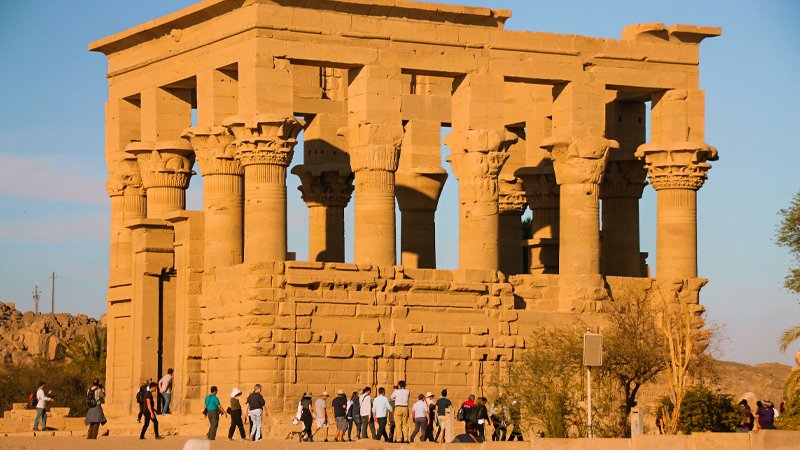Egypt’s allure extends beyond its towering pyramids and bustling cities. On the tranquil waters of the Nile, near the modern city of Aswan, lies the enchanting Philae Temple complex – a sanctuary dedicated to Isis, the goddess of love, magic, and healing. This sacred island, with its exquisite temples and captivating legends, transports visitors to a time when gods and goddesses reigned supreme. Join us on a journey to this extraordinary site, where history, mythology, and architectural grandeur intertwine in a symphony of stone.
A Sacred Isle: Philae’s Divine Origins
The ancient Egyptians believed that Philae Island was the final resting place of Osiris, the god of the afterlife. This belief imbued the island with a sacred aura, making it a pilgrimage site for worshippers from across Egypt. The first temple on Philae was built during the reign of Nectanebo I in the 4th century BC, dedicated to Isis. Over the centuries, other pharaohs and rulers added to the complex, creating a stunning ensemble of temples, colonnades, and gateways that stand as a testament to the island’s enduring religious significance.
Temple of Isis: A Testament to Divine Power
The Temple of Isis, the most prominent structure on Philae Island, is a masterpiece of ancient Egyptian architecture. Its grand pylon, adorned with reliefs depicting Isis and other deities, welcomes visitors to a world of divine power and mystery. Inside the temple, a series of hypostyle halls, adorned with towering columns and vibrant murals, lead to the innermost sanctuary, where a statue of Isis once stood. The temple’s walls are covered with intricate carvings depicting scenes from Egyptian mythology, offering a glimpse into the religious beliefs and practices of the time.
The Kiosk of Trajan: A Roman Tribute to Egyptian Deities
One of the most striking features of Philae Temple is the Kiosk of Trajan, a Roman-era structure built during the reign of Emperor Trajan in the 2nd century AD. This open pavilion, supported by fourteen columns with elaborate floral capitals, served as a ceremonial gateway to the Temple of Isis. The Kiosk’s reliefs depict Trajan making offerings to Isis and other Egyptian deities, highlighting the cultural exchange and religious syncretism that characterized the Roman period in Egypt.
A Rescue Mission: Relocating Philae Temple
The construction of the Aswan High Dam in the 1960s threatened to submerge Philae Island and its temples beneath the rising waters of Lake Nasser. In a remarkable feat of engineering and international cooperation, a project was launched to relocate the temples to the nearby Agilkia Island. The temples were carefully dismantled, piece by piece, and reassembled on Agilkia, ensuring their preservation for future generations. This monumental effort stands as a testament to the world’s commitment to safeguarding cultural heritage.
Unraveling the Myths: Isis and Osiris
The Philae Temple complex is deeply intertwined with the myths of Isis and Osiris, two of ancient Egypt’s most beloved deities. Isis, the goddess of magic, motherhood, and fertility, is often depicted as a protector of the dead and a guide to the afterlife. Osiris, her husband and brother, is the god of the underworld and the ruler of the afterlife. Their story, a tale of love, betrayal, and resurrection, is central to Egyptian mythology and is vividly depicted in the reliefs and carvings throughout the Philae Temple complex.
A Journey of Discovery: Exploring Philae Temple Today
Visiting Philae Temple today is a journey of discovery, a chance to step back in time and immerse yourself in the rich tapestry of ancient Egyptian history and culture. As you wander through the temples, colonnades, and gateways, you’ll be captivated by their beauty, complexity, and the stories they tell of a bygone era. Take a boat ride to the island, admire the breathtaking views of the Nile, and let the magic of Philae transport you to a world of gods, goddesses, and ancient rituals.
VII. Practical Tips for Visiting Philae Temple
Location: Philae Temple is located on Agilkia Island, near Aswan.
Getting there: Most visitors reach Philae Temple by taking a boat ride from Aswan. Boat trips are readily available and offer a scenic journey along the Nile.
Best time to visit: The best time to visit Philae Temple is during the cooler months, from October to April.
What to wear: Dress modestly, especially when visiting the temples. Bring a hat, sunglasses, and sunscreen to protect yourself from the sun.
Photography: Photography is allowed inside the temple complex, but flash photography is prohibited.
Conclusion: Philae Temple – A Timeless Treasure
Philae Temple, a sanctuary of love, devotion, and timeless beauty, is a must-visit destination for anyone traveling to Egypt. Its rich history, mythological significance, and architectural splendor offer a unique and unforgettable experience. Plan your visit to Philae Temple and discover the magic of this ancient Egyptian treasure.

